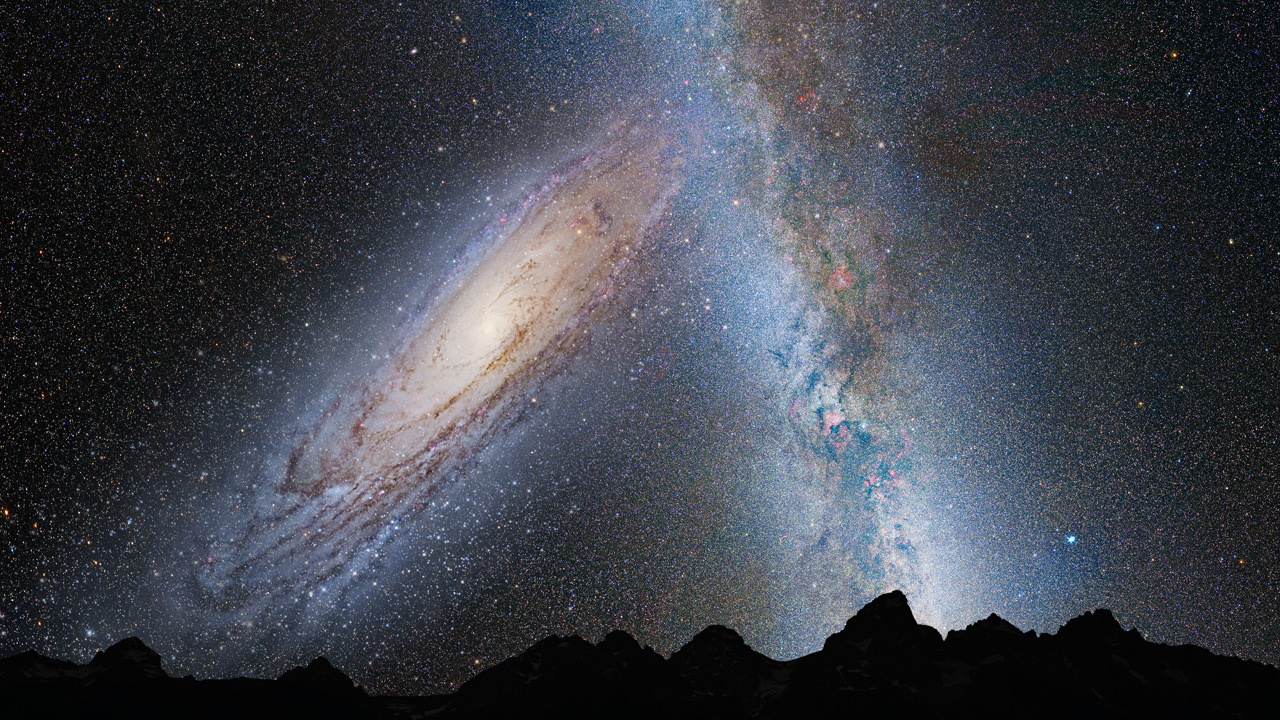New map created by AI reveals hidden links between Milky Way and Andromeda galaxies

A new cosmic map revealed hidden structures connecting galaxies, which could help scientists model a future collision between the Milky Way and Andromeda, our galaxy's nearest neighbor.
The map, made with machine learning, may also shed more light on dark matter's influence in the evolution of our universe, participating scientists said in a statement from Pennsylvania State University.
As for the collision between the Milky Way and Andromeda, which is expected to occur in 4.5 billion years, the map charted dark-matter filaments that bridge the two galaxies and that may affect the merger, the team said.
Related: Stunning photos of our Milky Way galaxy (gallery)
Dark matter represents roughly 80% of the matter in the universe, but it, along with dark energy, is poorly understood. Dark matter is invisible in wavelengths of light, so it can't be seen with telescopes. However, scientists can chart the influence of dark matter's gravity on large cosmic structures, such as galaxies.
"Because dark matter dominates the dynamics of the universe, it basically determines our fate," study co-author Donghui Jeong, an associate professor of astronomy and astrophysics at Penn State, said in the statement. "We can ask a computer to evolve the map for billions of years to see what will happen in the local universe. And we can evolve the model back in time to understand the history of our cosmic neighborhood."
The researchers built the map using machine learning, a type of artificial intelligence in which computers learn from a testing dataset to make their own decisions about classification. The scientists trained a model using a large set of galaxy simulations, called IllustrisTNG. The learning set included galaxies similar to our own, the Milky Way, with an aim to better understand what galactic properties best predict the distribution of dark matter.
Get the Space.com Newsletter
Breaking space news, the latest updates on rocket launches, skywatching events and more!
"Ironically, it's easier to study the distribution of dark matter much further away [from Earth] because it reflects the very distant past, which is much less complex," Jeong said. "Over time, as the large-scale structure of the universe has grown, the complexity of the universe has increased, so it is inherently harder to make measurements about dark matter locally."

Once the model was ready to start classifying information on its own, the researchers showed it real-life data from the Cosmicflows-3 galaxy catalog, which includes the movements and distribution of 17,000 galaxies within 200 megaparsecs of the Milky Way. (One parsec is roughly 3.26 light-years, which is about 19.2 trillion miles or 30.9 trillion kilometers.)
With the included data, the model accurately reproduced the Local Group of galaxies nearby the Milky Way, as well as a known "local void" that includes empty regions of space nearby, among other structures visible in the map.
The map also showed several new filaments that the team plans to study further, including those that connect our galaxy to Andromeda. The map will be even more accurate after NASA's $9.8 billion James Webb Space Telescope, which is expected to launch later this year, sends back data that will allow researchers to see even fainter, faraway galaxies, the researchers said.
"Having a local map of the cosmic web opens up a new chapter of cosmological study," Jeong said. "We can study how the distribution of dark matter relates to other emission data, which will help us understand the nature of dark matter."
A paper based on the research was published May 26 in The Astrophysical Journal. The team was led by Sungwook Hong, who has dual affiliations with the University of Seoul and the Korea Astronomy and Space Science Institute.
Follow Elizabeth Howell on Twitter @howellspace. Follow us on Twitter @Spacedotcom and on Facebook.
Join our Space Forums to keep talking space on the latest missions, night sky and more! And if you have a news tip, correction or comment, let us know at: community@space.com.

Elizabeth Howell (she/her), Ph.D., was a staff writer in the spaceflight channel between 2022 and 2024 specializing in Canadian space news. She was contributing writer for Space.com for 10 years from 2012 to 2024. Elizabeth's reporting includes multiple exclusives with the White House, leading world coverage about a lost-and-found space tomato on the International Space Station, witnessing five human spaceflight launches on two continents, flying parabolic, working inside a spacesuit, and participating in a simulated Mars mission. Her latest book, "Why Am I Taller?" (ECW Press, 2022) is co-written with astronaut Dave Williams.









